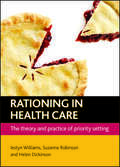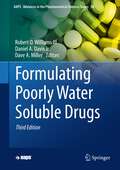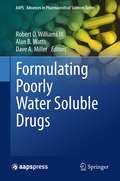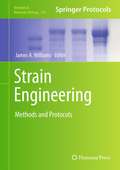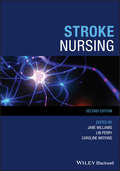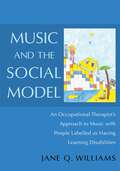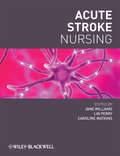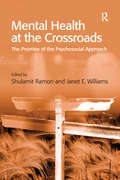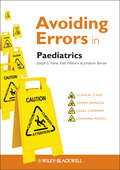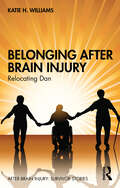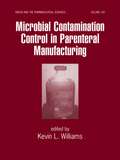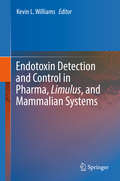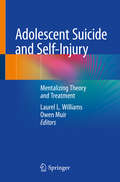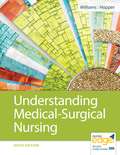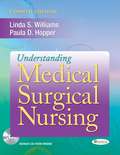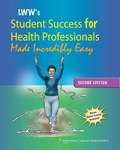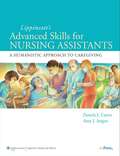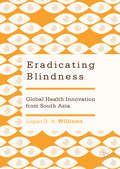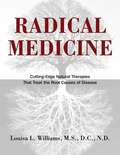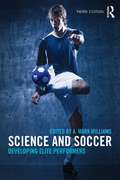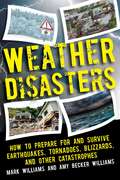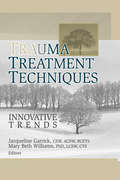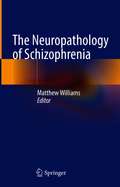- Table View
- List View
Rationing in health care: The theory and practice of priority setting
by Iestyn Williams Suzanne RobinsonThe challenges faced by those rationing scarce health care resources have intensified following the economic downturn. This book tackles this challenge by exploring the latest thinking and practice on priority setting methods. In an accessible style the book brings together theories, practice and evidence from a wide range of disciplines and provides practical, evidence-based prescriptions for decision makers. It will be of interest to all health care managers and students of health care policy and management.
Formulating Poorly Water Soluble Drugs (AAPS Advances in the Pharmaceutical Sciences Series #50)
by Robert O. Williams III Daniel A. Davis Jr. Dave A. MillerThe objective of this third edition is to consolidate within a single text the most current knowledge, practical methods, and regulatory considerations pertaining to formulations development with poorly water-soluble molecules. A pharmaceutical scientist’s approach toward solubility enhancement of a poorly water-soluble molecule typically includes detailed characterization of the compound’s physiochemical properties, solid-state modifications, advanced formulation design, non-conventional process technologies, advanced analytical characterization, and specialized product performance analysis techniques. The scientist must also be aware of the unique regulatory considerations pertaining to the non-conventional approaches often utilized for poorly water-soluble drugs. One faced with the challenge of developing a drug product from a poorly soluble compound must possess at a minimum a working knowledge of each of the above mentioned facets and detailed knowledge of most. In light of the magnitude of the growing solubility problem to drug development, this is a significant burden especially when considering that knowledge in most of these areas is relatively new and continues to develop.
Formulating Poorly Water Soluble Drugs
by Robert O. Williams III Alan B. Watts Dave A. MillerThis volume is intended to provide the reader with a breadth of understanding regarding the many challenges faced with the formulation of poorly water-soluble drugs as well as in-depth knowledge in the critical areas of development with these compounds. Further, this book is designed to provide practical guidance for overcoming formulation challenges toward the end goal of improving drug therapies with poorly water-soluble drugs. Enhancing solubility via formulation intervention is a unique opportunity in which formulation scientists can enable drug therapies by creating viable medicines from seemingly undeliverable molecules. With the ever increasing number of poorly water-soluble compounds entering development, the role of the formulation scientist is growing in importance. Also, knowledge of the advanced analytical, formulation, and process technologies as well as specific regulatory considerations related to the formulation of these compounds is increasing in value. Ideally, this book will serve as a useful tool in the education of current and future generations of scientists, and in this context contribute toward providing patients with new and better medicines.
Strain Engineering
by James A. WilliamsClassical methods for microbial strain engineering, used to improve the production of bioproducts, have serious drawbacks and have been found to be unsuitable for complex strain development applications. In Strain Engineering: Methods and Protocols, powerful new genetic engineering-based strain engineering methods are presented for rational modification of a variety of model organisms. These methods are particularly powerful when utilized to manipulate microbes for which sequenced and annotated genomes are available. Collectively, these methods systematically introduce genome alterations in a precise manner, allowing the creation of novel strains carrying only desired genome alterations. In the first section, E. coli-based bacterial strain engineering strategies are reviewed, while the second section presents analogous microbial engineering strategies for eukaryotic cells using the yeast Saccharomyces cerevisiae as a model. The third section covers examples of the proliferative adaptations of these base technologies to strain engineer industrially important prokaryotic or eukaryotic microbial systems. Written in the highly successful Methods in Molecular BiologyTM series format, chapters contain introductions to their respective topics, lists of the necessary materials and reagents, step-by-step, readily reproducible laboratory protocols, and notes on troubleshooting and avoiding known pitfalls. Authoritative and accessible, Strain Engineering: Methods and Protocols serves as an ideal guide to scientists in academia, pharmaceutical science, and biotechnology who perform microbial strain engineering.
Stroke Nursing
by Jane Williams Lin Perry Caroline WatkinsNurses are in contact with people at risk of, and following stroke, at every stage of their journey and in all settings. The market-leading guide for stroke nursing has been fully updated to reflect advances in clinical management of stroke, and provides a practical, evidenced-based, text to facilitate the provision of optimal stroke care during the primary prevention and acute phases. It also includes consideration of rehabilitation, recovery and discharge planning, which are integral to acute stroke management and the impact on the experience of life after stroke of individuals and their families. This essential text provides a greater focus on clinical application in practice, as well as an additional new chapter focused on the knowledge and skills required by nurses. • Explores UK and international perspectives on stroke management, and how it underpins management recommendations. • Structured to follow the acute stroke pathway experienced by patients. • Additional case studies and practice examples. • Explicitly links knowledge and skills to clinical practice required by clinicians in the provision of contemporary stroke care. • Authored by experienced and expert clinicians and leaders in the field of nursing practice, research and education.
Music and the Social Model: An Occupational Therapist's Approach to Music with People Labelled as Having Learning Disabilities
by Jane Williams Rachel PurtellMusic has always been an essential part of what it is to be human and yet not everyone has access to the music-based opportunities others take for granted. Motivated by the belief that individuals are disabled by society rather than any impairment they might have, Jane Williams sets out to show how someone with learning difficulties can engage with music in as many diverse and fulfilling ways as the rest of their community and generation. This practical guide will equip you with everything you need to know to help empower people with learning difficulties to experience and enjoy music, meaningfully. It sets out activity ideas in the context of existing Occupational Therapy models and offers a host of tips, resources and ready-to-use themed lesson plans to inspire and enrich your practice. There are also many practical examples and real-life success stories that show how to put the theory into practice, including downloadable tracks composed and performed by The LA Buskers, a band Jane works with. Accessible, practical and inspirational, the unique approaches described in this book will be of immeasurable interest to occupational therapists, social care workers responsible for planning and delivering activity programmes as well as community musicians.
Acute Stroke Nursing
by Jane Williams Caroline Watkins Lin PerryStroke is a medical emergency that requires immediate medical attention. With active and efficient nursing management in the initial hours after stroke onset and throughout subsequent care, effective recovery and rehabilitation is increased. Acute Stroke Nursing provides an evidence-based, practical text facilitating the provision of optimal stroke care during the primary prevention, acute and continuing care phases.This timely and comprehensive text is structured to follow the acute stroke pathway experienced by patients. It explores the causes, symptoms and effects of stroke, and provides guidance on issues such as nutrition, continence, positioning, mobility and carer support. The text also considers rehabilitation, discharge planning, palliative care and the role of the nurse within the multi-professional team. Acute Stroke Nursing is the definitive reference on acute stroke for all nurses and healthcare professionals wishing to extend their knowledge of stroke nursing.Evidence-based and practical in style, with case studies and practice examples throughoutEdited and authored by recognised stroke nursing experts, clinicians and leaders in the field of nursing practice, research and educationThe first text to explore stroke management from UK and international perspectives, and with a nursing focus
Mental Health at the Crossroads: The Promise of the Psychosocial Approach
by Janet E. WilliamsThis book is a challenge to the enduring status and domination of bio-medical approaches in mental health services. Contributors from four continents argue that this domination, along with modernization and multidisciplinary work, will not improve people's lives unless social and psychological perspectives are appreciated and integrated. This implies new forms of relationships and social arrangements. Mental Health at the Crossroads: the Promise of the Psychosocial Approach is a timely analysis of the psychosocial approach as it resonates across the discipline divide, considering the past and future development. It is written from the perspectives of service users and carers, managers, practitioners, educators, researchers and policy makers, illustrated with case studies from Australia, Brazil, Italy, UK and the USA. This book presents an alternative approach to conventional thinking in mental health, providing a fascinating and valuable resource for those seeking new perspectives, grounded in theory with practice examples, in order to influence the current agenda and change practice.
Avoiding Errors in Paediatrics
by Kate Williams Jonathan Bonser Joseph E. RaineSome of the most important and best lessons in a doctor's career are learnt from mistakes. However, an awareness of the common causes of medical errors and developing positive behaviours can reduce the risk of mistakes and litigation.Written for junior paediatric staff and consultants, and unlike any other paediatric clinical management title available, Avoiding Errors in Paediatrics identifies and explains the most common errors likely to occur in a paediatric setting - so that you won't make them. The first section in this brand new guide discusses the causes of errors in paediatrics. The second and largest section consists of case scenarios and includes expert and legal comment as well as clinical teaching points and strategies to help you engage in safer practice throughout your career. The final section discusses how to deal with complaints and the subsequent potential medico-legal consequences, helping to reduce your anxiety when dealing with the consequences of an error.Invaluable during the Foundation Years, Specialty Training and for Consultants, Avoiding Errors in Paediatrics is the perfect guide to help tackle the professional and emotional challenges of life as a paediatrician.
Belonging After Brain Injury: Relocating Dan (After Brain Injury: Survivor Stories)
by Katie H. WilliamsBelonging After Brain Injury: Relocating Dan explores the life of the author’s brother who has dealt with the effects of a severe traumatic brain injury (TBI) for over four decades. It recounts the institutional, psychological, and social labyrinths he and his family have navigated following the TBI he sustained at the age of eighteen. This insightful volume offers a holistic account of the impact of TBI on the survivor and his family. It reveals the difficulties a TBI survivor has had to endure and provides practical information about physical, psychological, and psychosocial symptoms and their consequences. Dan’s story offers new perspectives and strategies that will help alleviate seemingly intractable problems and highlights the central importance of forming connections with others in order to lead a fuller life. The author’s account of her own journey, learning to help care for and advocate for Dan, offers an invaluable guide for TBI survivors and those who care for and support them. Belonging After Brain Injury: Relocating Dan will be of interest to TBI survivors and their families. Its rich insights will be essential reading for medical and mental health professionals, as well those involved in the care and rehabilitation of TBI survivors and families.
Assessing the Implications of Allowing Transgender Personnel to Serve Openly
by Kayla M. Williams Srikanth Kadiyala Agnes Gereben Schaefer Radha Iyengar Jennifer Kavanagh Amii M. Kress Charles C. EngelThe U.S. Department of Defense is considering a change in policy to allow transgender military personnel to serve openly. A RAND study examined the health care needs of transgender personnel, the costs of gender transition-related care, and the potential readiness implications of a policy change. The experiences of foreign militaries that permit transgender service members to serve openly also point to some best practices for U.S. policymakers.
Microbial Contamination Control in Parenteral Manufacturing (Drugs And The Pharmaceutical Sciences Ser.)
by Kevin WilliamsThis reference surveys emerging trends, concepts, and procedures used in the characterization and control of contaminants; the sterile production of traditional drugs and biologics; the design, construction, and validation of new parenteral facilities; and the monitoring of clean environments-vividly illustrating the routes by which products, proce
Endotoxin Detection and Control in Pharma, Limulus, and Mammalian Systems
by Kevin L. WilliamsEndotoxin detection and control is a dynamic area of applied science that touches a vast number of complex subjects. The intersection of test activities includes the use of an ancient blood system from an odd “living fossil” (Limulus). It is used to detect remnants of the most primitive and destructive forms of life (prokaryotes) as contaminants of complex modern systems (mammalian and Pharma). Recent challenges in the field include those associated with the application of traditional methods to new types of molecules and manufacturing processes. The advent of “at will” production of biologics in lieu of harvesting animal proteins has revolutionized the treatment of disease. While the fruits of the biotechnology revolution are widely acknowledged, the realization of the differences in the means of production and changes in the manner of control of potential impurities and contaminants in regard to the new versus the old are less widely appreciated. Endotoxin as an ancient, dynamic interface between lifeforms, provides a singular perspective from which to view the parallel development of ancient and modern organisms as well as the progress of man in deciphering the complexity of their interactions in his efforts to overcome disease.
Adolescent Suicide and Self-Injury: Mentalizing Theory and Treatment
by Laurel L. Williams Owen MuirThis volume presents a comprehensive and practical approach to the treatment of suicide and NSSI for adolescents utilizing a mentalizing framework. The beginning of the text provides up-to-date information on the theory of a mentalizing therapy in order to ground the readers in the neuroscientific underpinnings of a mentalizing approach. Next chapters provide information on the fundamental building blocks of a mentalizing therapy at the individual and family level. These chapters provide step-by-step approaches in order to provide examples of the techniques involved in mentalizing treatment that can be employed to address suicidality and NSSI. The next chapter builds on these concepts as the reader learns about mentalizing failures involved in common co-morbidities in adolescents who are experiencing suicidality and/or employing NSSI. The next several chapters cover practical issues related to working within this patient population including the key concept of social systems and connections for both providers and adolescents, the ability of mentalizing theory and therapy to integrate with other effective therapies, how to approach sessions after a suicide attempt, resiliency for patient, family and the provider, along with important self-care for a therapist if a patient commits suicide. The final chapter brings all of the aforementioned elements together in order for the reader to conceptualize employing a mentalizing approach to adolescents and their families when suicide and NSSI concerns are a predominate focus of care. Illustrations of specific therapeutic approaches and a list of resources and guidelines where available are also included.Adolescent Suicide and Self-Injury is an excellent resource for all clinicians working with youths at risk for suicide and/or self-injury, including psychiatrists, psychologists, pediatricians, family medicine physicians, emergency medicine specialists, social workers, and all others.
Understanding Medical-Surgical Nursing
by Linda Williams Paula HopperEasy-to-read Nursing Care Plans feature the rationale for each action. Critical-thinking case studies and critical-thinking questions promote the transition from theory to practice. Geriatric content throughout familiarizes students with this important patient demographic. Learning tips promote understanding and retention of the material. End-of-chapter review questions with answers prepare students for chapter tests and for the NCLEX-PN. (Rationales are provided in the Student Resources on Davis Edge.) Nearly 2,000 NCLEX-style questions that align to Understanding Medical-Surgical Nursing with page references. Pre-set assignments that correlate directly to textbook content and the Davis's Nursing Skills Videos for LPN/LVN. Comprehensive rationales for both correct and incorrect answers to promote in-depth understanding. Test-taking tips to prepare students for exams and build their confidence. All different question types, including those that students struggle with like alternate format, select all that apply (SATA), prioritization and ordered response. Responsive design for access from laptop, tablet, and mobile devices.
Understanding Medical Surgical Nursing (4th Edition)
by Linda S. Williams Paula D. HopperThe 4th Edition of this groundbreaking textbook continues to teach the "why" of medical-surgical nursing more effectively than any other resource in the field. It presents complex issues in a clear and easy-to-understand manner that encourages students to think critically while applying theory to clinical practice.
Brunner And Suddarth's Handbook Of Laboratory And Diagnostic Tests
by Lippincott Williams Wilkins Staff Kerry H. Cheever Janice L. Hinkle SmeltzerThe second edition of Brunner & Suddarth's Handbook of Laboratory and Diagnostic Tests is a concise, portable, full-color handbook of hundreds of test results and their implications for nursing. Designed to accompany Brunner & Suddarth's Textbook for Medical-Surgical Nursing, 13th edition, this handbook provides readers with a quick-reference tool for use throughout the nursing curriculum, in clinicals, and in practice. <P><P> The two-part organization includes a review of specimen collection procedures, followed by a concise, alphabetical list of close to 300 tests and their implications. The entry on each test includes reference values or normal findings, abnormal findings with associated nursing implications, critical values, purpose and description of the test, interfering factors, and nursing considerations for patient care before, during, and after the test.
Student Success For Health Professionals
by Lippincott Williams Wilkins Staff Nancy OlrechThis Second Edition of Lippincott Williams & Wilkins' Student Success for Health Professionals Made Incredibly Easy has been revised and updated with a more user-friendly organization and design, but retains the health professions focus, the concise and approachable narrative, the fun features and art, and the self-paced online course of the first edition. It is still the first and only student success text designed specifically for health professions students and programs!
Advanced Skills For Nursing Assistants: A Humanistic Approach To Caregiving
by Lippincott Williams WilkinsThis text builds on the basic concepts and skills that the nursing assistant has already mastered. Recognizing that the students using this text have already completed their basic nursing assisting training and may have already been working in the profession, this text does not repeat information that is part of the basic nursing assistant training. Rather, this textbook is meant to be used in conjunction with, or as a follow-up to, a "basic" nursing assistant textbook, such as Lippincott's Textbook for Nursing Assistants.
Eradicating Blindness: Global Health Innovation From South Asia
by Logan D. WilliamsThis book describes community ophthalmology professionals in South Asia who demonstrate social entrepreneurship in global health to help the rural poor. Their innovations contested economic and scientific norms, and spread from India and Nepal outwards to other countries in Africa and Asia, as well as the United States, Australia, and Finland. This feminist postcolonial global ethnography illustrates how these innovations have resulted in dual socio-technical systems to solve the problem of avoidable blindness. Policymakers and activists might use this example of how to avoid Schumacher's critique of low labor, large scale and implement Gandhi's philosophy of good for all.
Radical Medicine: Cutting-Edge Natural Therapies That Treat the Root Causes of Disease
by Louisa L. WilliamsA “radical” approach to holistic healing that examines the root causes and cures for ailments such as Alzheimer’s disease, breast cancer, and heart attacks • Offers cutting-edge detoxification and draining therapies to address the tremendous chemical onslaught of modern life • Explains the profound health problems caused by dental amalgams, vaccinations, antibiotics, cosmetics With the historic use of toxic mercury amalgam fillings, excessive courses of antibiotics, damaging childhood vaccines, and the many industrial pollutants and chemicals that have been spread into our air, water, and food over the past century, general holistic health guidelines are simply no longer adequate for most people. Only through radical measures--that is, getting to the true root or underlying cause of disease--can effective healing occur. In Radical Medicine, naturopathic physician Louisa Williams describes how to treat these and other modern-day “obstacles to cure,” in order to ensure against future degenerative disease and achieve the optimal health that is our birthright. Examining the many health problems triggered by dental amalgams and poor dentistry, Dr. Williams explains that our teeth are focal points for health issues that arise elsewhere in the body. She explores the impact of vaccinations, the excessive use of antibiotics, and the chemical-laden products used as health and beauty aids--which are linked to Alzheimer’s disease, heart attacks, and breast and other cancers--and provides information on cutting-edge detoxification treatments as well as drainage and nutritional therapies. A practical guide for practitioners and patients alike, Radical Medicine offers a wealth of holistic, natural therapies for overcoming what is poisoning us and our world so we can achieve optimal health and well-being.
Science and Soccer: Developing Elite Performers
by Mark A. WilliamsNow in a fully revised and updated third edition, Science and Soccer is still the most comprehensive and accessible introduction to the physiology, biomechanics and psychology behind the world's most popular sport. Offering important guidance on how science translates into practice, the book examines every key facet of the sport, with a particular focus on the development of elite performers. The topics covered include: anatomy, physiology, psychology and biomechanics; principles of training; nutrition; physical and mental preparation; playing surfaces and equipment; decision-making and skill acquisition; coaching and coach education; performance analysis; talent identification and youth development. Science and Soccer: Developing Elite Performers is a unique resource for students and academics working in sports science. It is essential reading for all professional support staff working in the game, including coaches at all levels, physiotherapists, conditioning specialists, performance analysts, club doctors and sport psychologists.
Weather Disasters: How to Prepare For and Survive Earthquakes, Tornadoes, Blizzards, and Other Catastrophes
by Mark D. Williams Amy Becker WilliamsFloods. Blizzards. Landslides. Earthquakes. Tornadoes. Hurricanes. Severe weather happens every day across the globe. We see and hear of the devastating consequences whenever we tune into the evening news: property ravaged, communities destroyed, and lives lost. But although these events are unstoppable, you can prepare. In Weather Disasters, veteran authors and disaster survivors Mark and Amy Williams provide vital information on prepping for and surviving every major type of weather disaster. Each chapter is devoted to a different catastrophe, and lists: The science behind the catastrophe Essentials you’ll need to get through it Helpful prepping tips Statistics behind the disaster Resources to reach out to for help What to do in the aftermath No matter who you are or where you live, catastrophe can strike at any time. Be prepared, and pick up Weather Disasters today!
Trauma Treatment Techniques: Innovative Trends
by Mary Beth Williams Jacqueline GarrickExamine alternative techniques for dealing with post-traumatic stress disorderTrauma Treatment Techniques: Innovative Trends examines alternative approaches to "talk" therapies that help relieve stress in trauma survivors. Experts in a range of practice areas present mental health providers with methods that augment or go beyond traditional techniques, including art therapy, virtual reality, humor, residential programs, emotional freedom techniques (EFT), traumatic incident reduction (TIR), and thought field therapy (TFT). This unique book serves as a primer on new and creative means of working with combat veterans, survivors of child abuse, victims of rape and other violent crimes, refugees, victims of terrorism, and disaster survivors. Since the late 19th century, mental and medical health professionals, social workers, clinicians, and counselors have attempted to help patients mitigate symptoms and reduce distress by employing a variety of treatment techniques, methods, strategies, and procedures. Trauma Treatment Techniques: Innovative Trends represents a significant addition to the available literature on post-traumatic stress disorder (PTSD) and acute distress, providing therapists with much-needed options in their efforts to help trauma sufferers recover, find new meaning, and reach for new hopes and happiness.Trauma Treatment Techniques: Innovative Trends examines: debriefing interventions in school settings instructions and safeguards for using emotional freedom techniques (EFT) when debriefing in disaster situations the use of creative art therapies to reach out to war refugees the use of virtual reality-based exposure therapy (VRE) to desensitize Vietnam veterans with PTSD from traumatic memories humor as a healing tool repressed memory physiology and meridian treatment points in the body a six-step methodology for diagnosing PTSD a 90-day residential program for treatment of PTSD PTSD motivation enhancement (ME) groups autism as a potential traumatic stressor and much moreTrauma Treatment Techniques: Innovative Trends is an invaluable resource of inventive techniques that offer hope for recovery to anyone who has suffered life&’s worst injuries.
The Neuropathology of Schizophrenia
by Matthew WilliamsIn the past few decades, neuropathology has witnessed a resurgence. The rise of structural and functional imaging techniques has allowed pathological studies to target regions of special interest as revealed by whole-brain techniques, and the development of comprehensive software packages has facilitated cellular and pathological measurements. Furthermore, a new generation of antibodies and improved staining methods has made the field more accessible to researchers and revealed more detail than could once have been envisaged. Perhaps most important of all has been the sourcing of high-quality tissue through modern, large-scale databases covering multiple tissue banks, removing much of the heterogeneity that had made repeat studies all but impossible. The Neuropathology of Schizophrenia reviews the field following these recent improvements in techniques and contrasting more modern methods against older studies. This book presents the current state of neuropathological knowledge in schizophrenia by means of examination of neuropathology as informed by functional systems. It starts by considering the frontal cortical region, a particularly well-examined region of the brain, before moving through other cortical regions, subcortical pathways and the deep white matter. In addition, potential new routes for investigation are considered, particularly in glial cells.
